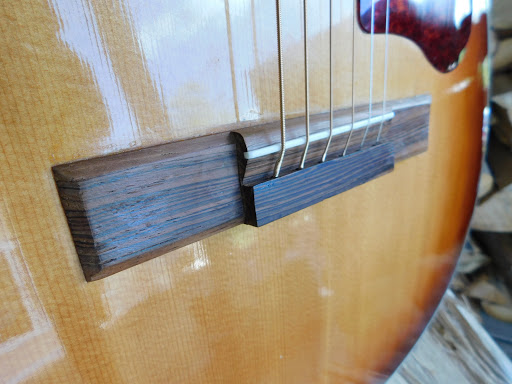
Welcome to Your Grandpa's Guitar. A blog dedicated to the guitars our grandparents may have owned. I hope to emphasize depression era instruments with an even greater emphasis on the so called working mans guitar. Guitars that were made and/or distributed by such companies as Regal, Sears and Roebuck(i.e. Supertone), Maybell/Slingerland, Tonk Brothers, Kay, Harmony and more. I hope you enjoy!!
Sunday, August 30, 2020
1969 Barclay Acoustic Guitar
Thursday, August 27, 2020
David Lindley
When it comes to catalog guitars few people were farther ahead of the curve in terms of their cool factor than David Lindley. It seems David has been playing these things most of his career. I could only imagine what his collection looks like and what a hoot it would be to sort through it and all it's oddities. David was the one who provided Ry Cooder with the gold foil pickup that balances out his Coodercaster.
This is Lindley's 2nd record with his band El Rayo-X. The front and back of the album cover are full of funky old guitars. Lindley was just looking for different sounds so he would scour the pawn shops trying to find something that didn't just sound like another Strat or Les Paul. On the front cover he is pictured with a late 50's Barney Kessel Kay Guitar with the Kelvinator headstock. His bass player and guitar player(Jorge Calderon and Bernie Larsen) are holding Airline Map bass and electric guitars with National branding on the headstock.
Here's a partial list of the guitars of the guitars that can be seen on the album... which by the way is a fun listen!!
Kay Barney Kessel
Airline Map bass and electric guitar
Danelectro Longhorn guitar
Teisco 6 string baritone/bass guitar
Danelectro Doubleneck
Silvertone 1457 or 1448 guitar( can only see the back of it so you can't tell if it is the single or double pickup model)
Its really impressive to think that this album came out in 1982. No one was playing these guitars back then.
Sunday, August 23, 2020
60's/70's Japanese Teleblaster
Mid '50's To Late 60's Regal Branded Parlor Guitars
 |
| These guitars are really cool, They are like mini Sovereigns. |
 |
| All solid woods on many of these old Harmony made guitars. Solid spruce top as well as mahogany back and sides. |
 |
| Definitely had to change out the tuners. The originals were crappy old strip tuners. |
 |
| Action is super low and fast |
 |
 |
| I love the little mysteries and inconsistencies about these guitars. You will note that the headstock on this one doesn't peak as much as the headstock on the shaded top guitar. |
 |
| Here is a final shot of the two parlors with their big Regal brother. |
Slingerland Songster 881-h
I posted this guitar a few years back but it merited another visit due its fantastic upgrade. Here we have a 1930's Slingerland Songster model 881-h. I will refrain from giving Slingerlands history in the world of stringed instruments mainly because a guy named Dave Kolar does a great job with that on his website - slingerlandguitar.com. I highly recommend it if you are into these guitars as well as their cousins in the Maybell brand.
I have owned this guitar for years in a somewhat unplayable state, finally getting it together and sending it off to Scott Baxendale in Athens, GA. Scott has a penchant for taking old catalog guitars and turning them into incredible instruments. I have done four instruments with Scott and the tone on this one was the biggest surprise yet. A beautiful tight tone that will be a killer in the recording studio. It is just right, not too boomy, not too thin. You add the killer vintage vibe that this guitar exudes and you can see why I cant put it down. Very simply(and obviously) stated... Guitars that make you want to play make you a better player!
Scott takes the back off and rebraces the instrument, planes the neck, refrets the neck, resets the neck, replaces the bridge and tuners if necessary and dials everything in perfectly. You can't buy a guitar that is this cool for what he charges. Its a good deal and he guarantees the work. If anything goes wrong you can send it back to him. He has multiple presences on the web, just google his name to learn more.
Spruce top, laminated maple back and sides, maple neck, rosewood fingerboard. 1.75" nut, fairly deep C shaped neck profile. Original specs state 11' upper bout and 15.5 inch lower bout. The lower bout on this guitar tops out at almost 15.75. This guitar does it all... fingerpick, flatpick, strum. You wouldn't think so given it looks like it is wearing a corset, but it responds beautifully. These are pretty rare guitars. I have only seen one other in my time.
New bridge, saddle and bridge pins. Oftentimes it is not practical to keep these guitars all original. The original bridge was lifting and pretty clunky. I would imagine this change alone added greatly to the tone, there is way less height and mass to this bridge. |
| Love this old repair! |
 |
| You can see the flame in the maple back. This old dog has had quite a life and is now on its second go around. |
























